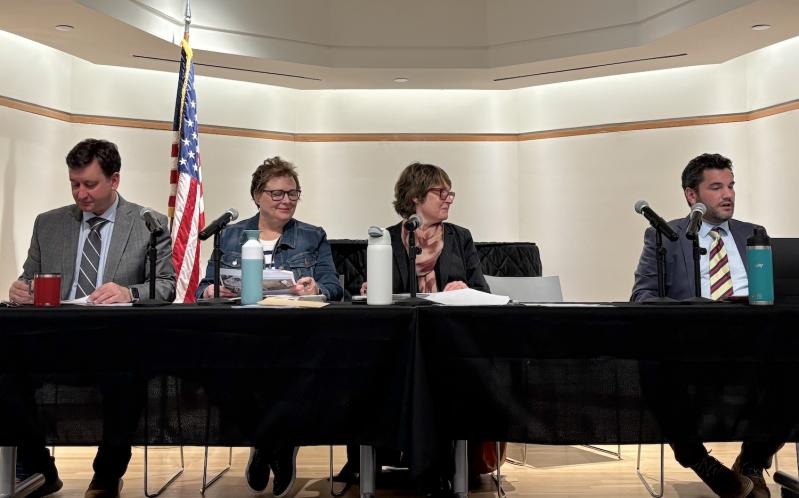A proposed amendment to the East Hampton Town Code that would allow certain projects to be defined as “community resources,” and thus exempt from compliance with the town zoning, planning, and architectural review board review, received a warm, if at times cautious, reception from the town board at its meeting on Tuesday.
“This is not a novel concept. There are a number of municipalities throughout the state that have exempted themselves from their own zoning codes,” Robert Connelly, the town attorney, told the board.
In addition, the town, if it adopted the code change, would be able to bypass the Monroe balancing test, which it used in the development of plans for the senior center to weigh community benefits against competing land interests. Further, the town would not need to follow its own clearing laws on residential lots in the harbor protection overlay district or the water recharge overlay district, nor would it need to obtain a natural resources special permit for any of its own projects. Mr. Connelly also suggested that a community resource might be exempt from the town’s use and dimensional tables.
Patrick Derenze, the public information officer for the town, said the other boards had not been notified about the potential code change before the meeting. “This was first discussed with the town board. It was a collaboration between [Supervisor] Kathee [Burke-Gonzalez], the Planning Department, town attorney, and [Councilwoman] Cate [Rogers]. Most of the town board had not seen the proposal until the work session, so it would not really make sense to move in that direction until we knew there was support on the board for it. Now that we have had that public discussion, it will go to the planning board for comment.”
Mr. Connelly presented the amendment to the board as a way to accommodate certain projects that “may not easily fit within the zoning regulations” and allow for their “swift development.”
The definition he offered was broad.
“A community resource would be defined as: A specific town-owned building, facility, infrastructure system, or geographic area of special economic development, environmental, scenic, cultural, historic, recreational, parkland, open space, natural resource, or other unique significance, located wholly or partially within the boundaries of the Town of East Hampton.”
“For some of these projects, like a dune restoration project, it’s also critical for it to move along rapidly to prevent damage,” Councilwoman Rogers said.
“Even if town board does exempt the town from its own zoning court, the town will still be in consultation with the Planning Department, the architectural review board, the zoning board. The town is still going to have to comply with [the State Environmental Quality Review Act] and other pertinent regulations, those from the Army Corps of Engineers, the New York State D.E.C., and Suffolk County Department of Health Services,” assured Mr. Connelly.
“This is a tricky thing,” said Councilman Ian Calder-Piedmonte. “Obviously we want to comply with our own rules.” However, he cited a couple of examples, such as needing Z.B.A. approval to remove phragmites, when the town had already received a permit to do so from the New York State Department of Conservation. Another redundancy might involve a project on a community preservation fund property, which he said were “often licensed out with great care.” The board has fiduciary responsibility, and removing redundancies is fiscally responsible, he said.
Ms. Rogers said that importantly, the town would still need to comply with the State Environmental Quality Review Act. “SEQRA is a very important guardrail for me,” she said. She argued that being exempt from the rules would “allow a more efficient and considerate look at where we place town assets. We wouldn’t be restricted to, say, commercial areas for commercial things. If we’re restricted to certain zones, then we’re restricting access to our public facilities.”
“While I understand there is a need for public discussion on this, people will have concerns that this allows the town to bypass boards, I don’t think that’s the case given the way the boards function,” Councilman Tom Flight said. “This is what we need to operate as a government.”
When asked if the proposed code changes were in response to the board’s experience with the senior center, Mr. Derenze offered a statement from Town Supervisor Kathee Burke-Gonzalez.
“The ‘community resource’ code change is tied to a wide range of ongoing town projects. Examples include phragmites and bamboo removal, dune reconstruction, the replacement of fencing and windows in historic districts, to large projects such as the remediation at the West Lake boat ramp as discussed on Tuesday.”
“It is also connected to the number of historic buildings the town has recently acquired,” the statement continued. “Many of these structures need to meet [Americans with Disabilities Act] and and safety standards in order to be used for public assembly.
“At the same time,” the supervisor said, “these projects already involve significant staff resources. Sending them through the same review process as private applications, often involving the same town staff members, increases delays to other applicants. The goal is to clarify the code so that we can move forward more efficiently on projects that serve the public, while continuing to maintain transparency and oversight.”
At the meeting, she said the public hearing could be noticed as early as next Thursday, April 17. If so, Mr. Connelly said a hearing could be held on May 1.



